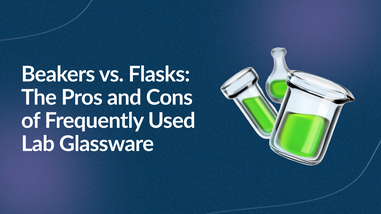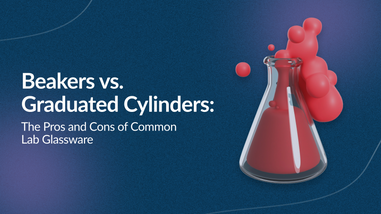- No products in the cart.
In chemistry, even the smallest mistake in liquid measurement can lead to inaccurate results, wasted materials, or failed experiments. That’s why mastering pipette technique is essential for reliable, repeatable data.
Proper pipette use maintains accuracy, prevents contamination, and ensures every result meets the highest lab standards. For those asking, “What is a pipette used for in chemistry?”, the answer lies in its role as a foundation of precision.
In this article, we’ll cover how a pipette works, the different types used in chemistry labs, step-by-step instructions for accurate handling, and best practices to maintain performance and compliance. We’ll also share how Lab Pro supports high-accuracy labs with calibrated, ISO-compliant pipettes built for consistent, traceable results.
Key Takeaways
-
Pipettes are essential for accurate liquid measurement and transfer in chemistry labs.
-
Understanding what a pipette is used for in chemistry helps ensure precision, consistency, and data reliability.
-
Different pipette types, volumetric, graduated, and micropipettes, serve specific experimental needs.
-
Proper pipetting technique prevents contamination and measurement errors.
-
Regular calibration and maintenance keep pipettes compliant with ISO and GMP standards.
-
Choosing the right pipette depends on liquid type, required precision, and workflow volume.
Understanding What A Pipette Does
A pipette is a simple but vital lab tool used to transfer very small amounts of liquid, from microliters to milliliters, with exact precision. In chemistry, accuracy matters because even a 1% error can change the outcome of an experiment or make test results unreliable. That’s why knowing what is a pipette used for in chemistry goes beyond the basic idea of liquid transfer, it’s about controlling every variable that affects data quality.
Most pipettes work on one of two principles: air displacement, used for general lab liquids, and positive displacement, used for thicker or volatile substances where accuracy is harder to maintain. In regulated environments like ISO, GMP, or FDA-certified labs, proper pipette handling, calibration, and documentation are crucial. Precision is required to ensure every result is valid, traceable, and compliant.

Types Of Pipettes And When To Use Each
Different experiments call for different types of pipettes. Choosing the right one can make all the difference in accuracy and workflow efficiency, especially when considering what a pipette is used for in chemistry and how it supports precision across various lab tasks.
Volumetric pipettes are designed for transferring one fixed, precise volume of liquid. They are commonly used in titrations, solution prep, and quality control testing.

Graduated pipettes have volume markings for flexible measurement. They are ideal for reagent transfers or when multiple volumes are needed in one session.

Micropipettes are used for very small liquid volumes in microliters. They are perfect for analytical chemistry, molecular biology, and cleanroom applications.

Multichannel pipettes allow simultaneous transfer of multiple samples. They are great for ELISA, PCR, or high-throughput assays.

Electronic Pipettes automate repetitive work, improving accuracy and reducing hand strain.

Also, read:
Step-By-Step Guide: How To Use A Pipette Correctly
Knowing "What is a pipette used for in chemistry" is only half the story, using it correctly is what ensures accuracy and consistent results. A pipette may seem simple, but proper handling makes the difference between precise data and costly errors. Here’s a clear, practical guide to help you get every measurement right.
-
Preparation: Start by choosing the right pipette and tip size for the volume of liquid you need. Make sure your pipette is clean, calibrated, and working properly before use. Let the pipette, tips, and samples reach room temperature to prevent volume changes due to temperature differences.
-
Aspiration: Hold the pipette vertically to ensure accuracy. Press the plunger down to the first stop, then submerge the tip just below the liquid’s surface, about 2–3 mm for thin liquids or slightly deeper for viscous ones. Slowly release the plunger to draw the liquid up.
-
Dispensing: To release the liquid, touch the pipette tip to the inner wall of the receiving container. Press the plunger to the first stop, pause briefly, then press to the second stop to expel all liquid completely. Slide the tip along the container wall as you remove it to prevent any droplets from being left behind. This simple technique helps maintain accuracy and repeatability, which is essential when understanding what a pipette is used for in chemistry.
-
Ejection and Post-Use Care: After dispensing, eject the used tip with the ejector button instead of removing it by hand to prevent contamination. Wipe the pipette gently if needed and place it back in its stand vertically.
COMMON MISTAKE: Holding the pipette at an angle greater than 30° can reduce accuracy by 1–2%.
COMPLIANCE TIP: Record pipette serial numbers and calibration details in your lab logbook for traceability and audit readiness.

Maintenance, Calibration, And Compliance
No matter what a pipette is used for in chemistry, its accuracy depends on regular care and calibration. A well-maintained pipette ensures reliable results, reduces error, and keeps your lab compliant with quality standards.
-
Routine Maintenance: Clean the piston and shaft regularly, replace worn seals, and check the calibration status. Keeping components clean prevents buildup that can affect volume accuracy.
-
Calibration Frequency: Calibrate every 3–6 months, depending on how often the pipette is used. All calibrations should be traceable to ISO 8655 standards to meet industry and audit requirements.
-
Verification Methods: Use gravimetric testing (weighing dispensed water) or photometric analysis (measuring absorbance) to verify precision between calibrations.
-
Documentation: Keep calibration certificates and service records up to date. Proper records ensure full traceability during ISO, GMP, or FDA audits.
-
When to Replace: Swap out pipettes showing inconsistent draw, stiff plungers, or visible leaks, these are signs of wear that can affect data accuracy.
Lab Pro offers professional, ISO-compliant pipettes that are always audit-ready and performing at peak precision.
Industry-Specific Pipetting Applications
Pipetts also supports specific industries. Each sector relies on pipettes differently, but all depend on accuracy and consistency.
-
Biotech and Life Sciences: Used for preparing PCR samples, DNA/RNA quantification, and enzyme assays. Pre-calibrated micropipettes help ensure repeatable results in gene expression and protein analysis.
-
Semiconductor and Electronics: Pipettes handle cleanroom-grade and ESD-sensitive fluids safely. A semiconductor R&D lab, for example, uses Class A pipettes to maintain chemical purity in deposition or etching workflows.
-
Medical Device and Pharmaceutical: Pipettes ensure accurate reagent preparation, formulation, and quality control testing to meet FDA and GMP requirements.
-
Research and Education: In academic settings, calibrated pipettes help students learn accurate lab techniques and maintain consistency in experimental results.
Choosing The Right Pipette For Your Lab
The right pipette depends on your liquid type, precision requirements, and daily workflow. For example, air displacement pipettes work best for aqueous samples, while positive displacement models handle viscous or volatile liquids more accurately. Also, consider ergonomics for comfort during repetitive work, cleanroom compatibility, and ongoing calibration support to maintain precision.
Every experiment depends on accuracy, and mastering pipette use ensures every result you produce is reliable, reproducible, and compliant. Whether you’re preparing reagents, running titrations, or managing sensitive samples, precision begins with proper pipette technique and calibration.
At Lab Pro, we help laboratories maintain peak performance with ISO compliant calibration services. We also provide a full range of high-quality pipettes and accessories, including volumetric, electronic, and micropipettes, along with cleanroom-compatible supplies, PPE, and chemical solutions for regulated environments. With same-day local delivery across California and responsive customer support, Lab Pro helps labs stay compliant, efficient, and well-equipped.
FAQs
Can you use the same pipette for aqueous and non-aqueous solvents?
In many cases, you can, but only if your pipette and tips are compatible with the solvents. When asking “What is a pipette used for in chemistry?”, consider whether the liquid is acidic, volatile, or viscous. For non-aqueous or viscous fluids, use a dedicated positive-displacement or solvent-safe pipette to avoid damaging the instrument and maintain accuracy.
How can I confirm a pipette’s accuracy between calibration events?
A quick verification involves dispensing a known volume of distilled water and weighing it (gravimetric test). This helps answer “What is a pipette used for in chemistry beyond basic use?” and ensures it still performs within tolerance. If the weight is out of spec, schedule a full calibration.
Is one type of pipette always best for chemistry labs?
Not really. Recognizing what a pipette is used for in chemistry means matching the pipette to your workflow. For example, volumetric pipettes excel in analytical titrations, while electronic or multichannel pipettes are better for high-throughput assays. The “best” choice depends on volume range, chemical type, and throughput.
How often should a pipette be recalibrated in a regulated chemistry environment?
Many labs follow a calibration cycle of every 3–6 months, but frequency depends on usage, chemical compatibility, and audit requirements. For labs asking “What is a pipette used for in chemistry?” having documented calibration (traceable to ISO 8655) ensures compliance and precision.
What tip method should I use when working with very small volumes (<1 µL)?
When dealing with microscale transfers, a pipette with low-retention tips or special coating reduces sample loss. Understanding what is a pipette used for in chemistry at this scale underscores the need for optimal tip-pipette pairing to maintain accuracy in sensitive assays.












































